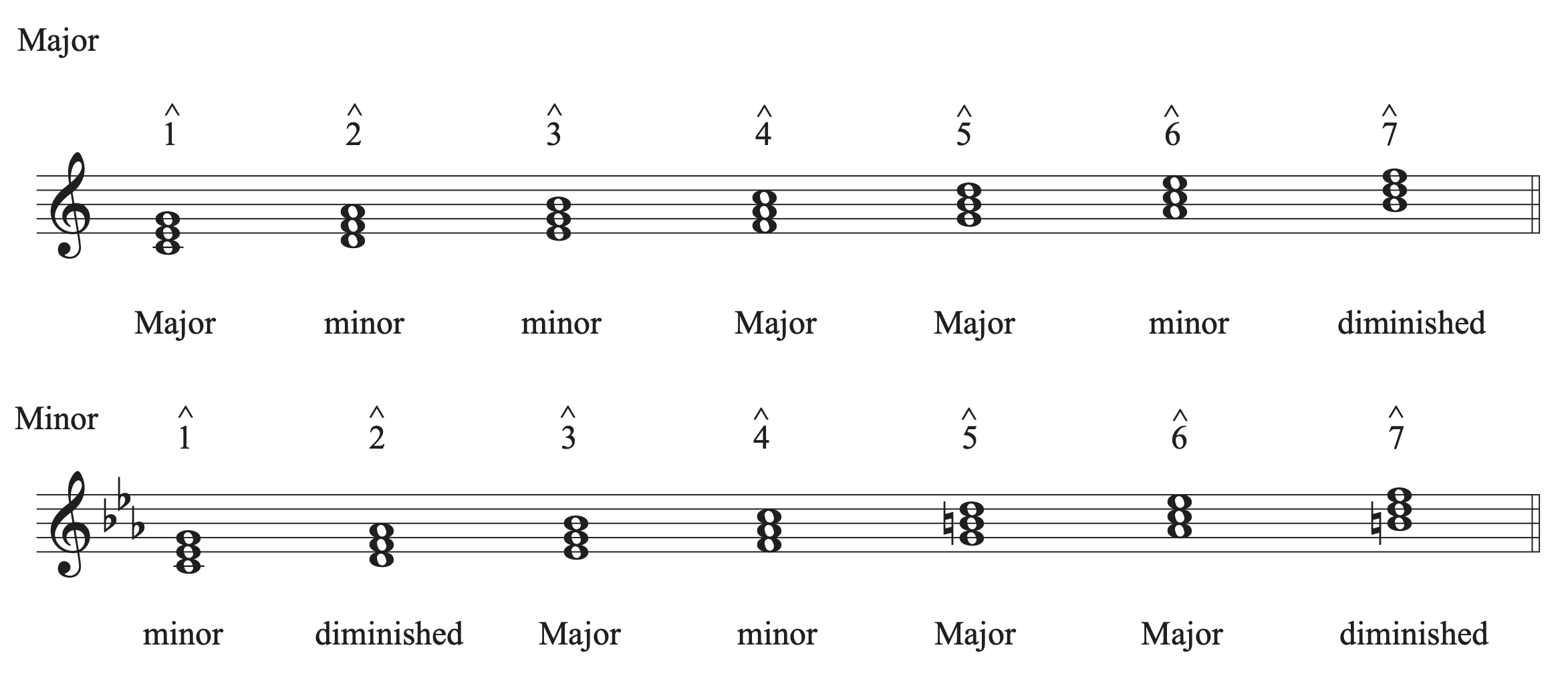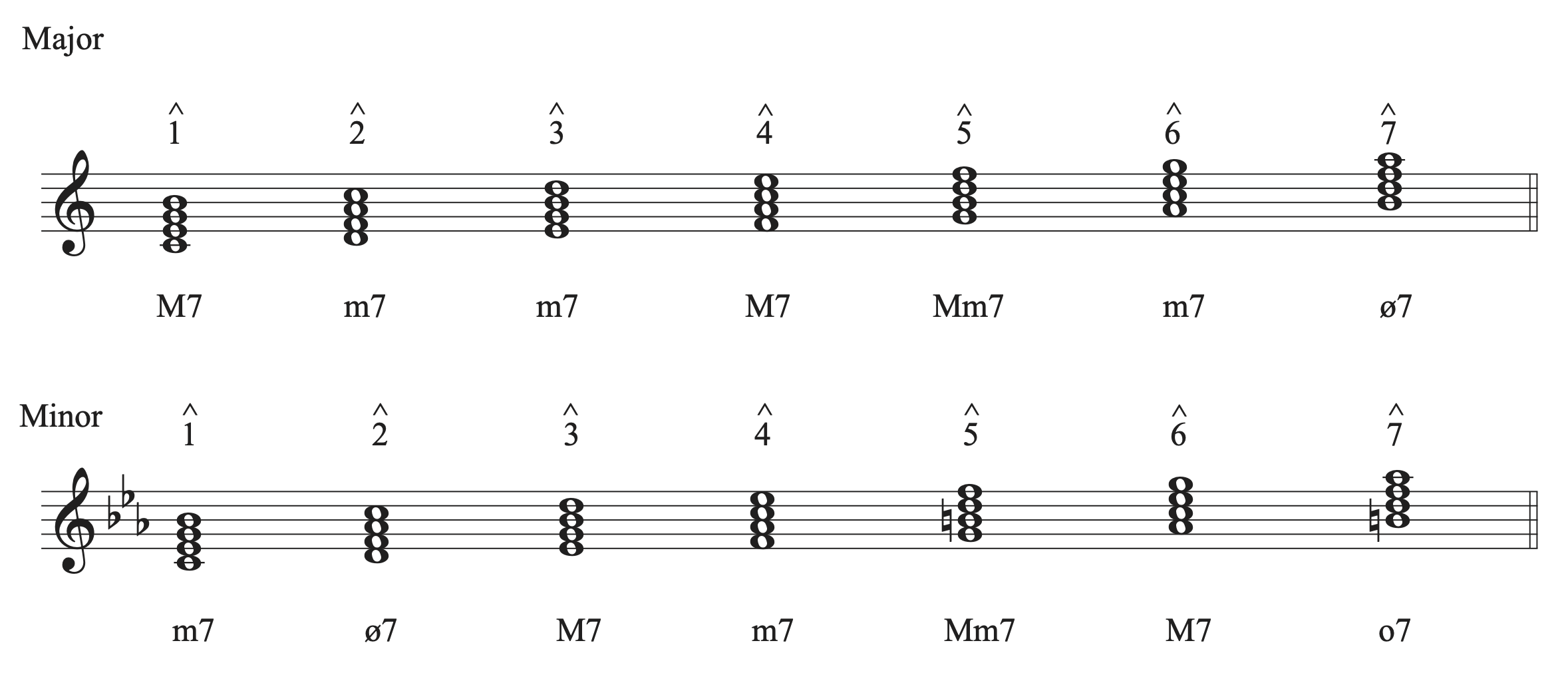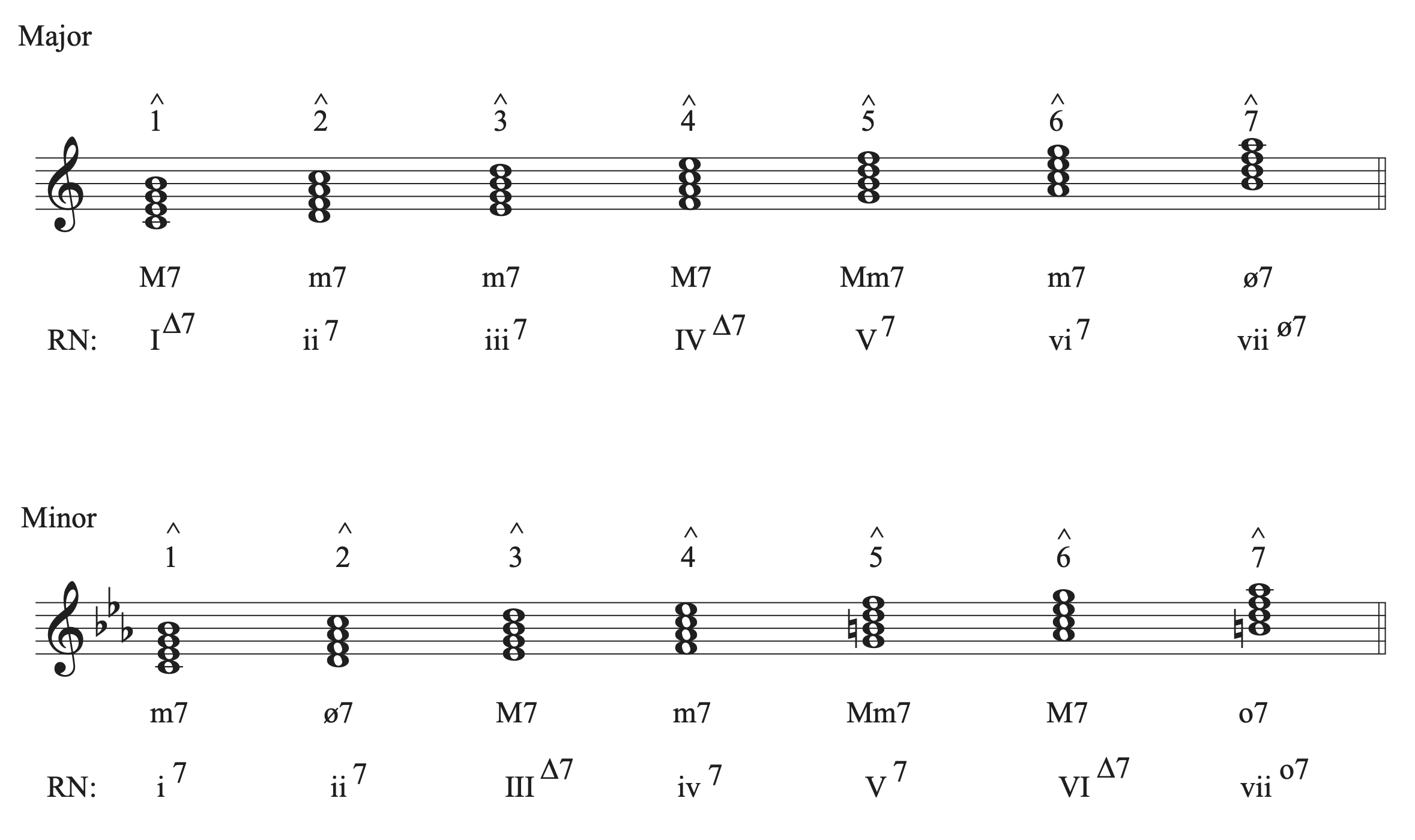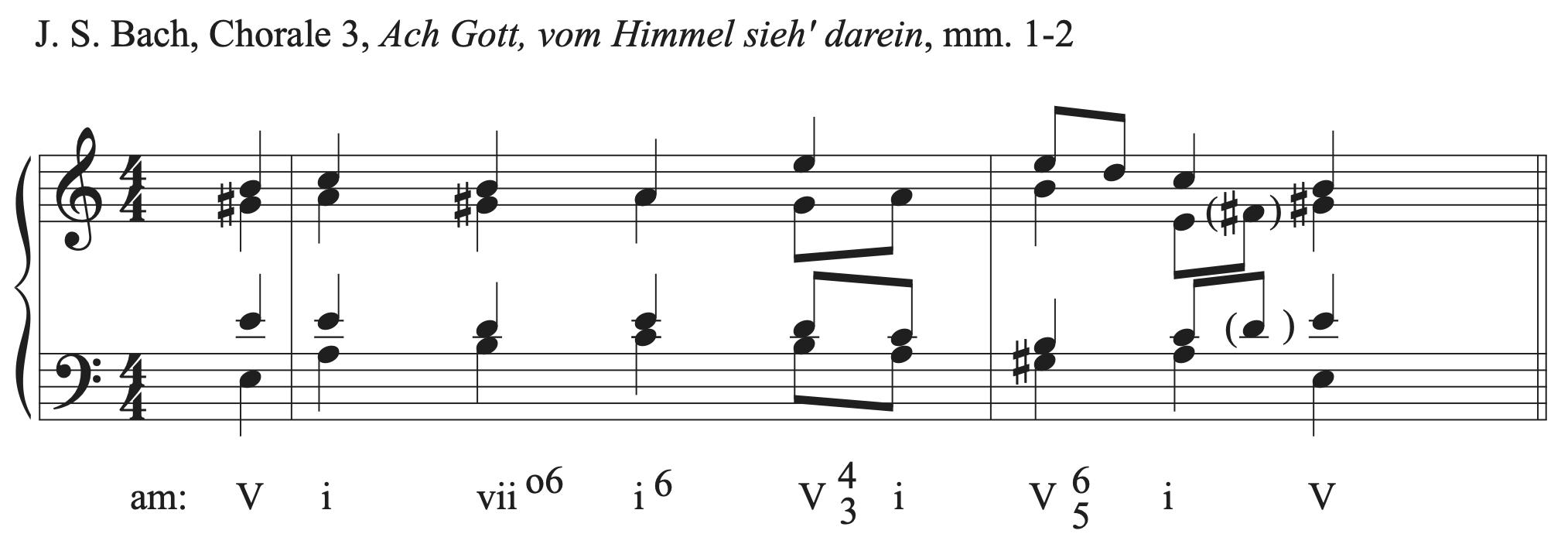5.5 Roman Numerals and Diatonic Harmony: Tutorial
Roman Numerals
Roman Numerals are another type of system for labeling chords in music. Like lead sheet symbols and figured bass symbols, Roman Numerals tell us what chord is being played and what inversion it is in. What Roman Numerals can do that lead sheet symbols and figured bass symbols cannot, is indicate the function of a chord in a key. For this reason, they are the standard system of chord labeling used in music theory.
A Review of Scale Degree Names
Scale degree names were discussed in the chapters on major and minor scales. Each scale degree in a key has a degree of tension that needs to be resolved and a functional relationship with those chords around them within the key. Each scale degree in a key has a name that indicates its function in the key.
| Scale Degree | Name | Name comes from |
| 1 | tonic | “home base,” most stable pitch, beginning and end point |
| 2 | supertonic | Pitch right above tonic (super means above) |
| 3 | mediant | Pitch halfway between tonic and dominant |
| 4 | subdominant | Pitch right below the dominant (sub means below) |
| 5 | dominant | Dominant to tonic is an important motion in tonal music. We can see one instance of that in the Circle of 5th motion through keys in music. |
| 6 | submediant | Sub in this case means opposite the mediant. The mediant is a 3rd above tonic and the submediant is a 3rd below the tonic. |
| 7 | leading tone | The leading tone is a tendency tone with a strong drive to lead and resolve to 1. |
| b7 | subtonic | When scale degree 7 has not been raised in a minor key, it is called the subtonic because it is below tonic. |
Diatonic vs. Chromatic chords
Diatonic chords are those found within a key. Chords built on each scale degree in a key use the key signature for that key. Chromatic chords are those that are altered by using accidentals that do not occur in the key. When analyzing music in a key, we expect diatonic chords built on each scale degree to have specific qualities. This is a list of the qualities of diatonic triads in major and minor keys:

Notice that in minor, we raise the leading tone on chords built on scale degrees 5 and 7. We do that because those chords function as dominant category chords, which lead back to tonic. We will learn more about this aspect of functional harmony in the chapter on functional harmony. We consider chords with a raised leading tone in minor to be diatonic chords because they are found as part of the harmonic and ascending melodic minor scales in minor keys.
Just like diatonic triads have an expected quality in major and minor keys, seventh chords do as well. Here is a list of the qualities of diatonic seventh chords in major and minor keys.

Memorize the qualities found for both triad and seventh chords in major and minor keys. Knowing what to expect on each chord can help you analyze music quickly and find chromatic chords that our outside of the key.
Roman Numerals: Triads
Roman Numerals are symbols used to label chords based on their scale degree positions in a key. The scale degree of the root of a chord is listed using a Roman Numeral. The Roman Numeral is upper case if the chord is major or augmented and lower case if the chord is minor or diminished. For example, a major chord build on scale degree 1 would be labeled as I. A minor chord built on scale degree 1 would be labeled as i. When labeling Roman Numerals, make sure there is an obvious different between your lower and uppercase letters. Hand written capitalized Roman Numerals use a horizontal line across the top and bottom of the numbers to clearly differentiate capital from lower case. An augmented triad would be symbolized by an uppercase letter as well as by a plus sign: I+. This distinguishes its quality from major. A diminished triad would be symbolized by a lowercase letter plus a small circle, like a degree sign: vii˚. This distinguishes its quality from minor. Memorize the list of the diatonic triads found in major and minor keys labeled with Roman Numerals:

Roman Numerals: Seventh Chords
Like triads, Roman Numerals for seventh chords are labeled based on scale degree position in a key. Capital Roman numerals are used for major-major and major-minor seventh chords followed by a 7 to indicate the chord is a seventh chord instead of a triad. To distinguish between them, major-major seventh chords use a superscript triangle symbol or capital M placed before the 7, while major-major seventh chords just use the Roman Numeral followed by 7. Minor-minor seventh chords use a lower case Roman Numeral followed by a 7 without any other quality symbol between. Half-diminished seventh chords use a lower case number followed by superscript ø7. Fully-diminished seventh chords use a lower case number followed by superscript o7. Memorize the list of the diatonic seventh found in major and minor keys labeled with Roman Numerals:

Symbolizing Chord Inversions Using Roman Numerals
Like lead sheet symbols, Roman Numerals indicate chord inversions as part of the their symbol. Roman Numeral inversion symbols are called bass position symbols and evolved from the figured bass symbols commonly used for each type of chord. A triad in first inversion is labeled with 6/5 after its Roman Numeral. Though in writing, we add a slash between the two numbers, when writing the inversion next to a Roman Numeral, the numbers are stacked with the 6 on top of the 5, like it is in figured bass notation. A triad in second inversion is labeled with 6/4. Seventh chord inversion labels also come from figured bass symbols. A seventh chord in first inversion would be labeled 6/5. A second inversion seventh chord would be labeled 4/3, and a third inversion would be labeled 4/2. The following example shows what bass position symbols look like when added to Roman numerals. Notice their position next to the Roman numerals.

Summary
Roman Numerals are labeled according to scale degree placement in a key, and can show chord function in a way that lead sheet symbols and figured bass cannot.
Memorize the diatonic triads and seventh chords found in each key and the symbols for chord inversion:
Triads In major:
- Major triads: I, IV, V
- Minor triads: ii, iii, vi
- Diminished triad: vii˚
- Augmented triad: none
Triads In minor:
- Major triads: III, V, VI
- Minor triads: i, iv
- Diminished triads: ii˚, vii˚
Triad inversion symbols:
- First inversion: 6
- Second inversion 6/4
Seventh chords in major:
- M7: I∆7, IV∆7
- Mm7: V7
- m7: ii7, iii7, vi7
- ø7: viiø7
Seventh chords in minor:
- M7: III∆7, VI∆7
- Mm7: V
- m7: i7, iv7
- ø7: iiø7
- ˚7: vii˚7
Seventh chord inversion symbols:
- First inversion: 6/5
- Second inversion: 4/3
- Third inversion: 4/2
Roman Numeral Analysis
Now that you understand Roman Numerals, you can use them to label chords in music. Here are the steps to doing an analysis:
- Determine the key and write the key below the bass line, to the left of first chord. Get in the habit of always including the key when writing Roman numerals. Major keys can use capital letters and an uppercase M followed by a colon sign, while minor keys can use lower case letters and a lowercase m followed by a colon sign. Roman numerals are always placed below the staff under their corresponding chords.
- Stack the chord in thirds in root position, eliminating doubled tones. Double check accidentals that are part of the key signature or that carry through from earlier in the bar. Double check the rhythm to make sure that all chord tones are accounted for. Eliminate any notes that do not belong in the chord by putting those notes in parenthesis.
- Identify the chord, including the root, quality, and inversion.
- Provide a Roman Numeral label based on the scale degree of the root of the chord, including symbols for quality and inversion as needed.
Use the steps above to guide your analysis of the piece below. Cover the Roman numerals to see if you can analyze the chords correctly, then compare your answers to those given.

Create an analysis of the music you are currently practicing or studying using Roman Numerals. How does looking at the chord progression functionally within a key change your understanding of the music? What do you gain from using Roman numerals that you do not get from using lead sheet symbols or figured bass notation? Which system is easier to read in the moment? Which system is easier to use to understand the relationships between the chords in the key? When might you choose to use one system over the other in your life?

